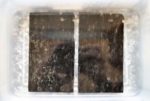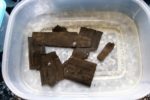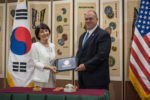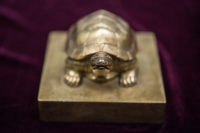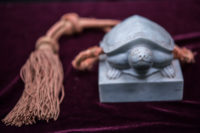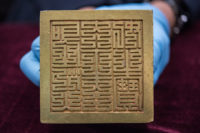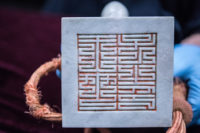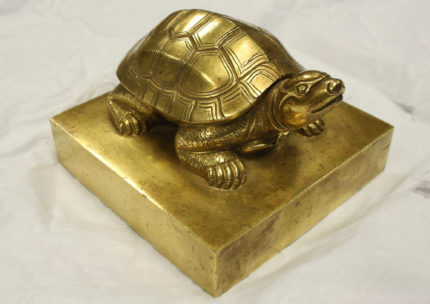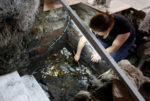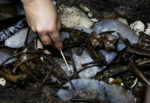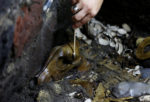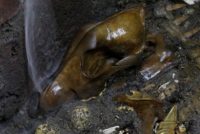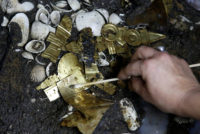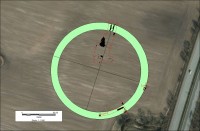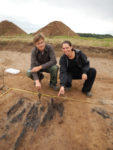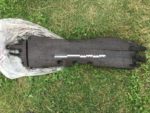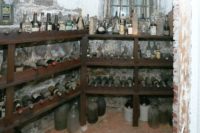 Workers renovating Liberty Hall Museum at Kean University in Union, New Jersey, discovered a rare collection of Madeira wines, some dating back to Colonial times. Museum staff knew the Kean family had wine storage shelves in the cellar, but they were obscured by a plaster and plywood wall built during Prohibition. When workers broke through the wall and the locked wooden cage behind it, they found a collection of 18th and 19th century wines far larger than they realized. There are three cases containing more than 50 bottles of Madeira, the oldest of which date to 1796. The attic held an unexpected wine cache as well, not in bottles but in 42 demijohns dating to the 1820s. It’s the oldest and largest known collection of Madeira in the United States.
Workers renovating Liberty Hall Museum at Kean University in Union, New Jersey, discovered a rare collection of Madeira wines, some dating back to Colonial times. Museum staff knew the Kean family had wine storage shelves in the cellar, but they were obscured by a plaster and plywood wall built during Prohibition. When workers broke through the wall and the locked wooden cage behind it, they found a collection of 18th and 19th century wines far larger than they realized. There are three cases containing more than 50 bottles of Madeira, the oldest of which date to 1796. The attic held an unexpected wine cache as well, not in bottles but in 42 demijohns dating to the 1820s. It’s the oldest and largest known collection of Madeira in the United States.
The museum staffers cataloged the cases and jugs of Madeira as they were discovered. While some of the stock needed to be researched online, most of the wine was still labeled with handwritten tags, or could be looked up in the thousands of Liberty Hall documents dating more than 200 years.
“We have the receipts from the liquor store, or the liquor distributor in New York, in Elizabeth or wherever,” [Liberty Hall director of operations Bill] Schroh said. “We can also trace the purchaser, when it was purchased and who it was purchased from.”
Part of the research showed some of the Madeira was imported by Robert Lenox, a millionaire merchant from New York who owned land in the heart of Harlem, which is where the borough’s main avenue gets its name.
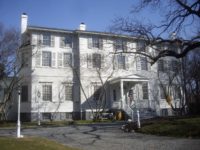 Liberty Hall was the country home of William Livingston, scion of a prominent New York family and a successful lawyer. When he bought the land in Elizabethtown (now Elizabeth), New Jersey, he planned to retire to the estate. He was intimately involved in the design of the 14-room Georgian home and of the landscaping and orchards on the 120-acre property. He and his wife settled in to their happy retirement home in 1773, but Livingston’s retirement wouldn’t even last a full year. Revolution pulled him back into political and military action. He was a delegate to both Continental Congresses, was a general in the New Jersey militia and was New Jersey’s first elected governor in 1776.
Liberty Hall was the country home of William Livingston, scion of a prominent New York family and a successful lawyer. When he bought the land in Elizabethtown (now Elizabeth), New Jersey, he planned to retire to the estate. He was intimately involved in the design of the 14-room Georgian home and of the landscaping and orchards on the 120-acre property. He and his wife settled in to their happy retirement home in 1773, but Livingston’s retirement wouldn’t even last a full year. Revolution pulled him back into political and military action. He was a delegate to both Continental Congresses, was a general in the New Jersey militia and was New Jersey’s first elected governor in 1776.
Livingston was only able to return to Liberty Hall in 1783 and the estate had been rudely treated by the British who trashed the place on the regular searching for him when he was a wanted man. American soldiers also looted the home. Livingston lovingly repaired the home and gardens, even as he continued to serve as governor until his death in 1790.
The hall was purchased by Peter Kean, the son of Livingston’s niece Susan, in 1811. Peter and his mother maintained the estate for the next 22 years. In 1833, Susan’s grandson Colonel John Kean inherited it and over the course of six decades, transformed the Georgian home into a 50-room Victorian mansion. It has remained in the Kean family who have worked to preserve it and open it to the public as a museum displaying original artifacts from the Livingston and Kean families in rooms dedicated to different time periods.
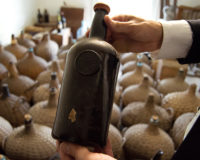 It seems the wines were collected by both the Livingstons and the Keans.
It seems the wines were collected by both the Livingstons and the Keans.
Some of the original Madeira stock was shipped to the second generation who lived at Liberty Hall, in anticipation of John Adams’ presidency. Although Liberty Hall President John Kean was well aware of the wine collection, he couldn’t have imagined its historical significance.
“We knew there was a lot of liquor down here, but we had no idea as to the age of it,” said Kean, first cousin to New Jersey’s former governor. “I think the most exciting part of it was to find liquor, or Madeira in this case, that goes back so far. And then trying to trace why it was here and who owned it.”
Madeira was a popular tipple for the early American upper crust, because unlike most wines at that time, it can take a lot of jostling of the kind sure to be experienced on a trans-Atlantic ocean voyage. The fortified dessert wine also lasts far longer than other wines without spoiling or turning to vinegar. In the 18th century, the 13 colonies bought 95% of the Madeira produced on the Portuguese archipelago and gentlemen of wealth and good taste would have a selection of Madeiras in their cellars (or attics). The Liberty Hall collection has six different kinds of Madeira.
The newly liberated cellar space with its original wooden shelves, now restored and structurally reinforced, is open to the public, along with some of the bottles and demijohns. John Kean had the opportunity to taste a sample from one of the Madeiras and he said it tasted fine, like a sweet sherry. The bottles from 1796 have not been sampled. They might be whipped out for an appropriate special occasion in the future: a visit from the President of Portugal.





